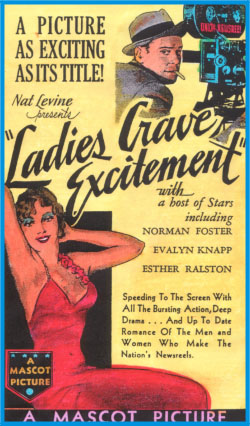Mascot Pictures
| Industry | Film studio |
|---|---|
| Founded | 1927 |
| Defunct | 1935 |
| Fate | Merged |
| Successor | Republic Pictures |
| Headquarters | First: Santa Monica Boulevard, Los Angeles, United States Later: Studio City, Los Angeles, California, United States |
Key people | Nat Levine |
| Products | The King of the Kongo (1929) The Shadow of the Eagle (1932) In Old Santa Fe (1934) The Phantom Empire (1935) |
Mascot Pictures Corporation was an American minor film company of the 1920s and 1930s best known for producing and distributing film serials and B-westerns. Mascot's serial The King of the Kongo (1929) was the first serial to include sound, beating Universal Studios by several months.
Mascot was formed in 1927 by film producer Nat Levine. In 1935 it merged with several other companies to form Republic Pictures.
The company's logo featured a roaring tiger resting on top of a model of the planet Earth.
Early years
Mascot was created by Nat Levine, a former personal secretary to Marcus Loew, in 1927 after the success of his independent serial The Silent Flyer (1926).
In the beginning the company operated out of the upstairs offices of a contractor's business on Santa Monica Boulevard. It rented all of its equipment and facilities.
In 1929 the studio made serial history with the production of The King of the Kongo. This was the first serial, from any production company, to be made with sound. Mascot's first all-talking production was The Phantom of the West (1931)
Sennett Studios

By 1933 Mascot was successful enough to rent, and later buy, Sennett Studios after the original owner, silent-film comedy producer-director Mack Sennett, went bankrupt because of the Great Depression. This made the company a true film studio. That studio lot is now CBS Studio Center.
Mascot was responsible for the popularity of the concept of the "singing cowboy" and the "musical western". In 1935 the studio produced The Phantom Empire with the then untried Gene Autry as the lead.
Republic Pictures
Mascot's film developer was Consolidated Film Industries, known as CFI. In 1935, under pressure from that company's owner, Herbert Yates, Mascot merged with CFI and Monogram Pictures, Liberty Pictures, Chesterfield Pictures and Invincible Pictures to form the larger Republic Pictures. Mascot became the serial and B-Western arm of the company, along with its studio. Along with other things, Monogram provided its distribution network, and technical and financial elements came from CFI.
Legacy
Several careers began at Mascot Pictures.
Actors
Production crew
Filmography
- Men with Steel Faces (1940)
- Doughnuts and Society (1936)
- The Fighting Marines (1935)
- Harmony Lane (1935)
- Confidential (1935)
- Waterfront Lady (1935)
- Streamline Express (1935)
- The Adventures of Rex and Rinty (1935)
- Ladies Crave Excitement (1935)
- The Headline Woman (1935)
- One Frightened Night (1935)
- The Miracle Rider (1935)
- Behind the Green Lights (1935)
- The Phantom Empire (1935)
- Little Men (1934)
- Mystery Mountain (1934)
- The Marines Are Coming (1934)
- In Old Santa Fe (1934)
- Crimson Romance (1934)
- Young and Beautiful (1934)
- The Law of the Wild (1934)
- Burn 'Em Up Barnes (1934)
- The Lost Jungle (1934) (serial)
- The Lost Jungle (1934) (feature variation)
- The Lone Defender (1934)
- The Mystery Squadron (1933)
- The Wolf Dog (1933)
- Laughing at Life (1933)
- Fighting with Kit Carson (1933)
- The Whispering Shadow (1933)
- The Three Musketeers (1933)
- The Devil Horse (1932)
- Pride of the Legion (1932)
- The Hurricane Express (1932)
- The Last of the Mohicans (1932)
- The Shadow of the Eagle (1932)
- The Lightning Warrior (1931)
- The Galloping Ghost (1931)
- The Vanishing Legion (1931)
- King of the Wild (1931)
- The Phantom of the West (1931)
- The Lone Defender (1930)
- The King of the Kongo (1929)
- The Fatal Warning (1929)
- Vultures of the Sea (1928)
- The Vanishing West (1928)
- Heroes of the Wild (1927)
- Isle of Sunken Gold (1927)
- The Golden Stallion (1927)
Additionally,
- The Silent Flyer (1926) was created by Nat Levine but was not in the strict sense of the word a Mascot production.
See also
- List of film serials by studio includes a list of serials produced by Mascot.
Further reading
- The Vanishing Legion: A History of Mascot Pictures 1927–1935; Tuska, Jon; 1999 (McFarland Classics); ISBN 978-0-7864-0749-1
External links
- Entertainment companies established in 1927
- Media companies established in 1927
- Companies disestablished in 1935
- Defunct American film studios
- Mascot Pictures films
- Film distributors of the United States
- Entertainment companies based in California
- Companies based in Los Angeles
- 1927 establishments in California
- 1935 disestablishments in California
- Defunct companies based in the Greater Los Angeles Area
- Republic Pictures films
